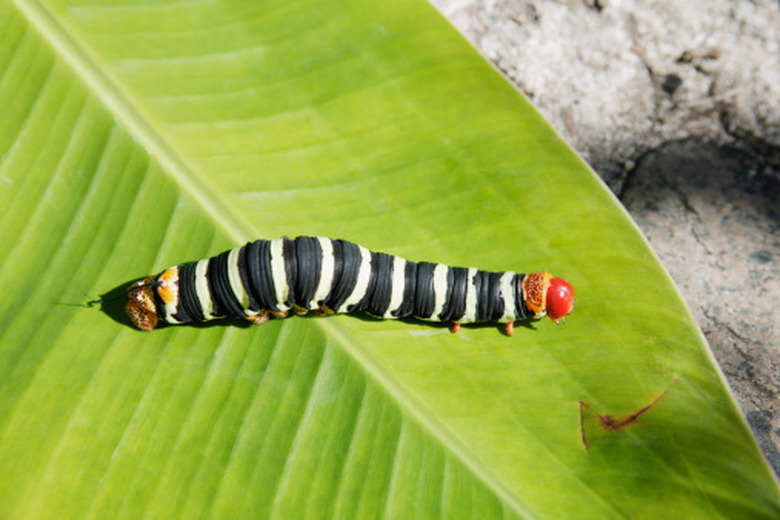Garden Pests: Black Caterpillars With White & Red Stripes
Many different kinds of caterpillars are black with white and red markings on their bodies. Most black, white and red caterpillars come from the many families of moths and cause little serious destruction. They are not considered garden pests. However, one caterpillar, the azalea caterpillar (Datana major), is a different creature, indeed. It, too, is a moth larvae, but unlike its saintly cousins, causes considerable damage to plants throughout the southeastern United States.
Description
Female moths emerge in late spring and lay 80 to 100 eggs on the undersides of food plant leaves. The caterpillars that emerge are approximately 3/8-inch long, with a yellowish body with seven red longitudinal stripes. They eat in groups and can defoliate a plant in no time. As the tiny caterpillars grow, they take on their hallmark colors. A mature caterpillar is two inches long, with a black body covered in broken yellow or white stripes and a bright red head and legs.
- Many different kinds of caterpillars are black with white and red markings on their bodies.
- Most black, white and red caterpillars come from the many families of moths and cause little serious destruction.
Preferred Plants and Damage
Although they are known as azalea caterpillars, Datana major will happily munch a variety of plants. Anything in the Rhododendron family is at particular risk. These caterpillars have been seen in significant numbers on blueberries, red oak, andromeda and apples. An infestation of azalea caterpillars results in leaves that are heavily skeletonized. Eventually, the affected leaves dry up and drop off the plant.
Control
Several methods of control exist. A small infestation is generally handled by hand-picking the caterpillars and destroying them before they can mature and lay more eggs. Larger infestations are treated with biological methods or insecticide. Bacillus thuringiensis is a bacterial pathogen that affects a wide range of larval insects, including azalea caterpillars. It is generally safe for humans, pets and plants. Insecticides such as carbaryl, cyfluthrin or spinosad are used when a large, visible population of azalea caterpillars are present, though the use of insecticides can reduce the number of beneficial insects in your garden.
- Although they are known as azalea caterpillars, Datana major will happily munch a variety of plants.
- An infestation of azalea caterpillars results in leaves that are heavily skeletonized.
Similar Catepillars
There are many other black caterpillars with white and red stripes. If you do not observe the caterpillar in question doing significant damage, you may have one of the benign caterpillars instead. The caterpillars of the echo moth (Seirarctia echo), arge moth (Grammia arge), spurge hawkmoth (Hyles euphorbiae) and camphorweed cucullia (Cucullia alfarata) meet a similar description. These caterpillars are not known to be serious garden pests, however.
References
- North Carolina State University; Summer Azalea Pest Management; Danny Lauderdale; August 2008
- Clemson University; Azalea & Rhododendron Insect Pests; Clyde S. Gorsuch and J. McLeod Scott; Revised May 2004
- University of Florida Department of Entomology; Azalea Caterpillar; G.W. Dekle and Thomas R. Fasulo; June 2000
